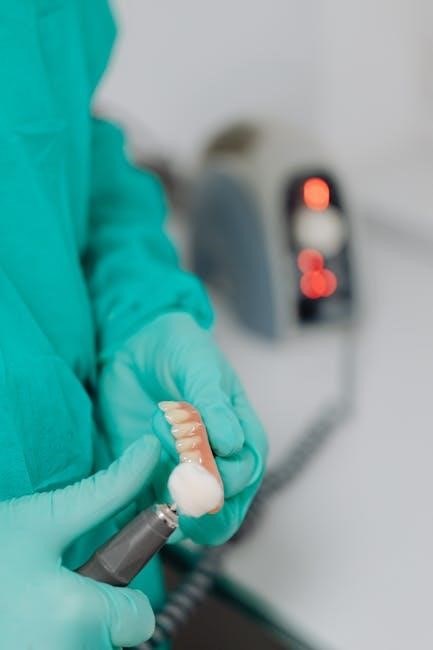A dental health history form is a crucial document used by dentists to gather detailed medical and dental information about patients. It ensures safe, personalized treatment by updating every two years, covering medical history, current health status, dental history, and patient consent. This form helps dentists understand potential risks and tailor care effectively, fostering trust and open communication between patients and dental professionals.
What is a Dental Health History Form?
A dental health history form is a document used by dental professionals to collect comprehensive information about a patient’s medical and dental background. It typically includes details such as medical conditions, allergies, medications, previous dental treatments, and lifestyle factors that may impact oral health. The form is usually completed by the patient before their dental visit and is updated periodically, often every two years, to ensure accuracy. It also covers consent for treatment and privacy agreements, aligning with regulations like HIPAA. The form is essential for identifying potential risks, such as medical conditions that could affect dental care, and ensures personalized treatment plans. Patients are encouraged to provide honest and detailed information to help dentists deliver safe and effective care. This document serves as a foundation for understanding each patient’s unique health needs and ensures open communication between patients and dental professionals.

Purpose of the Dental Health History Form
The primary purpose of a dental health history form is to gather essential information about a patient’s medical and dental background to ensure safe and effective care. It helps dentists identify potential health risks, such as medical conditions, allergies, or medications that could impact treatment. The form also collects details about past dental procedures, current symptoms, and lifestyle factors influencing oral health. By understanding a patient’s overall health, dentists can tailor treatments to individual needs and avoid complications. Additionally, the form serves as a legal document, ensuring compliance with privacy regulations like HIPAA and obtaining patient consent for treatment. It fosters open communication, allowing patients to ask questions and clarify concerns, and ensures accurate, up-to-date records for ongoing care. This comprehensive approach enhances patient safety and the quality of dental services provided.

Importance of Dental Health History Form
A dental health history form is vital for ensuring patient safety, enabling personalized treatment plans, and avoiding complications. It ensures legal compliance and maintains patient privacy, fostering transparent communication between dentists and patients.
Why is a Dental Health History Form Essential?
A dental health history form is essential because it provides dentists with critical information about a patient’s medical and dental background. This ensures safe and effective treatment planning by identifying potential risks, allergies, or health conditions that could impact care. By understanding a patient’s health history, dentists can avoid complications and tailor treatments to individual needs. Additionally, it fosters trust and transparency, as patients feel their health is prioritized. Regular updates every two years help keep records current, adapting to changes in health status. This form is a cornerstone of preventive care, enabling early detection of issues and promoting overall well-being.
How It Improves Patient Safety and Care Quality
A dental health history form significantly enhances patient safety by identifying medical conditions, allergies, and risks that could impact treatment. This information allows dentists to avoid adverse reactions and tailor care to individual needs, ensuring safer procedures. By understanding a patient’s health background, dentists can make informed decisions, reducing complications and improving outcomes. The form also promotes high-quality care by enabling personalized treatment plans that address specific dental and medical concerns. Additionally, it streamlines the treatment process by providing a clear overview of the patient’s history, saving time and ensuring accuracy; Overall, the form acts as a safeguard, improving both patient safety and the effectiveness of dental care. It fosters trust by demonstrating a commitment to understanding and addressing each patient’s unique health needs.

Components of a Dental Health History Form
A dental health history form typically includes sections for medical history, dental history, and additional information. It collects details about medical conditions, allergies, previous treatments, and patient consent, ensuring comprehensive care.
Medical History Questions
Medical history questions in a dental health history form are designed to gather essential information about a patient’s overall health. These questions typically inquire about current medical conditions, such as diabetes or heart disease, as well as allergies to medications, latex, or other substances. Patients are also asked about medications they are currently taking, including dosages, to avoid drug interactions during treatment. Additionally, questions about past illnesses, surgeries, or hospitalizations are included to assess potential risks. Family medical history may be requested to identify genetic predispositions to certain conditions. Questions about lifestyle factors, such as smoking or recreational drug use, are often included to evaluate their impact on oral health. Lastly, patients are asked if they are under the care of a physician or have any medical conditions that could affect dental treatment. Accurate and up-to-date information is crucial for ensuring safe and effective care. Patients are encouraged to update their medical history every two years or as their health status changes.
Dental History Questions
Dental history questions in a health history form focus on understanding a patient’s oral health background. These questions typically ask about the reason for the dental visit, current pain or discomfort, and the patient’s opinion on their dental health. Patients are also asked about their dental care habits, such as frequency of brushing, flossing, and dental check-ups. Questions about previous dental treatments, including fillings, extractions, or orthodontic work, are included to assess existing conditions. Additionally, patients may be asked about their satisfaction with their smile and any concerns about the appearance of their teeth. Some forms inquire about past experiences with dental anxiety or fear, as well as any issues with dental materials or treatments. This information helps dentists tailor care to individual needs, ensuring comprehensive and personalized treatment. Accurate responses enable dentists to identify potential risks and develop appropriate treatment plans. Regular updates to this section are essential for ongoing care.
Additional Information Sections
Beyond medical and dental history, dental health history forms often include additional sections to gather comprehensive patient information. These may cover lifestyle factors, such as smoking or alcohol use, which can impact oral health. Family medical history is another common section, as it helps identify genetic risks for conditions like periodontal disease or tooth decay. Some forms also inquire about patient preferences, such as fears or anxieties related to dental care, to ensure a comfortable experience. Additionally, sections on consent and privacy are included to comply with legal requirements, ensuring patients understand how their data will be used. These extra details provide a holistic view of the patient’s health, enabling dentists to deliver personalized and effective care while addressing any special needs or concerns. This comprehensive approach ensures safe, tailored, and legally compliant treatment.

The Process of Completing the Form
Patients typically fill out the form upon arrival, providing accurate medical and dental history. Dentists review it to discuss concerns and ensure safe, personalized care, fostering trust and clarity.
Patient’s Role in Filling Out the Form
Patient’s active participation is vital in completing the dental health history form. They must accurately provide detailed medical and dental information, including current health status, medications, allergies, and previous treatments. Patients should honestly disclose any medical conditions, such as heart issues or diabetes, and note lifestyle factors like smoking or alcohol use. They are encouraged to ask questions if unclear about any section to ensure understanding; Updating the form every two years ensures relevance and safety. Patients’ transparency aids dentists in tailoring care, minimizing risks, and improving outcomes. Their role in providing accurate and up-to-date information fosters trust and collaboration, ensuring personalized and effective dental care.
Dentist’s Role in Reviewing the Form
Dentists play a critical role in reviewing the completed dental health history form to ensure patient safety and personalized care. They must thoroughly analyze the information provided, identifying any medical conditions, allergies, or medications that could impact treatment. This review enables dentists to assess risks, such as bleeding disorders or drug interactions, and adjust procedures accordingly. They should also verify the accuracy of the information and address any discrepancies or unclear responses. Dentists are responsible for explaining the form’s purpose and ensuring patients understand its importance. By carefully reviewing the form, dentists can tailor treatment plans to individual needs, minimizing complications and enhancing overall care quality. Regular updates to the form, typically every two years, ensure ongoing accuracy and relevance for continuous patient well-being.

Legal and Privacy Considerations
Dental health history forms must comply with legal standards like HIPAA to protect patient privacy. Ensuring confidentiality and secure handling of sensitive information is essential. Patient consent is required for data collection and sharing.
HIPAA Compliance and Patient Privacy
HIPAA compliance is essential for safeguarding patient health information in dental practices. Dental health history forms must adhere to the Privacy Rule, ensuring that patient data remains confidential and secure. Practices should implement measures like secure storage, limited access, and employee training to protect sensitive information. Patients have the right to access their records and request corrections. Sharing patient data without consent is prohibited, except for authorized healthcare purposes. Dental offices must maintain transparency about how patient information is used and shared. Regular audits and updates to policies help ensure ongoing compliance. By prioritizing patient privacy, dental professionals build trust and uphold legal obligations, ensuring that health information is handled responsibly and ethically at all times.
Importance of Patient Consent
Patient consent is a fundamental aspect of dental care, ensuring that individuals are fully informed and agree to their treatment. It establishes a mutual understanding between the patient and dentist, respecting patient autonomy. Consent must be voluntary, informed, and specific to the procedure or information being shared. In the context of dental health history forms, obtaining consent ensures that patients agree to the collection, use, and disclosure of their personal and medical information. This process is legally required and protects both patients and healthcare providers. Clear communication about treatment options, risks, and benefits is essential for valid consent. Patients must be able to make informed decisions about their care, free from coercion. Consent also fosters trust and transparency, encouraging patients to actively participate in their dental health management. Regular updates to consent forms ensure ongoing compliance with legal and ethical standards, safeguarding patient rights throughout their care journey.

Benefits for Dentists and Patients
Dental health history forms provide accurate patient information, enhancing treatment safety and efficiency. Patients benefit from personalized care, while dentists gain essential insights for informed decisions, improving overall outcomes.
How Dentists Benefit from Accurate Information
Dentists greatly benefit from accurate information provided on dental health history forms. This ensures they can deliver safe, personalized treatment tailored to each patient’s unique medical and dental needs. Accurate records help identify potential risks, such as allergies or medical conditions, which are crucial for avoiding complications during procedures. Detailed dental histories enable dentists to track changes in oral health over time, making diagnoses more precise. Additionally, having a comprehensive understanding of a patient’s health reduces legal risks and improves communication, fostering trust between dentists and their patients. By relying on accurate information, dentists can make informed decisions, ensuring high-quality care and optimal outcomes for all patients.
Patient Benefits from Transparent Communication
Patient benefits from transparent communication are significant, as it fosters trust and ensures they are well-informed about their care. By completing a dental health history form, patients provide essential details that guide personalized treatment, ensuring their safety and comfort. Transparent communication also helps patients understand their treatment options, enabling them to make informed decisions. This openness reduces anxiety and builds a stronger patient-dentist relationship. Additionally, clear communication ensures patients are aware of their rights, including privacy protections under HIPAA, and understand the importance of providing accurate information. When patients feel heard and informed, they are more likely to adhere to treatment plans and maintain better oral health. Transparent communication empowers patients, making them active participants in their dental care journey. This mutual understanding leads to better health outcomes and a more positive overall experience.

Challenges and Considerations
Completing dental health history forms accurately is crucial, as errors can impact treatment safety. Patients may struggle to recall medical details, while language barriers and complex terms can hinder understanding. Ensuring privacy and compliance with regulations like HIPAA is essential to maintain trust and avoid legal issues.

Common Challenges in Completing the Form
Patients often face challenges when filling out dental health history forms, such as remembering detailed medical or dental histories. Language barriers and complex terminology can lead to misunderstandings or incomplete information. Additionally, some individuals may hesitate to disclose sensitive health details, fearing privacy breaches. Dentists must ensure forms are clear and easy to understand, while also addressing patient concerns to encourage accurate and thorough responses. Regular updates to the form and staff training can help mitigate these issues, improving the quality of data collected and ensuring safer, more personalized care for patients. Effective communication and a supportive environment are key to overcoming these challenges and fostering trust between patients and dental professionals.
Special Considerations for Vulnerable Patients
Vulnerable patients, such as those with learning disabilities, cognitive impairments, or severe anxiety, may require additional support when completing dental health history forms. These individuals often need assistance understanding complex questions or may struggle to communicate their medical history effectively. Dentists should provide clear, simple language and allow patients to ask questions or seek help from caregivers. For patients with mental health conditions or phobias, a gentle and reassuring approach can help reduce anxiety. Ensuring privacy and confidentiality is especially important for vulnerable individuals, as they may feel sensitive about sharing personal health details. Dentists should also be prepared to adapt communication strategies, such as using visual aids or involving family members, to ensure accurate and informed responses. Special considerations like these help create a more inclusive and patient-centered care environment.

The Future of Dental Health History Forms
The future of dental health history forms lies in digital solutions, enhancing patient care through electronic data collection and HIPAA-compliant systems, ensuring security and improving communication between patients and dentists.
Digital and Electronic Forms
Digital and electronic dental health history forms are revolutionizing patient care by streamlining data collection and improving accuracy. These forms, often in PDF format, can be easily accessed and completed online through patient portals, reducing waiting times at the clinic. They also enhance security, with features like encryption and HIPAA-compliant platforms to protect sensitive patient information. Digital forms allow for real-time updates, ensuring that medical and dental histories are current and accurate. Additionally, electronic formats reduce paperwork and minimize errors associated with handwritten submissions. Patients benefit from the convenience of submitting forms remotely, while dentists gain faster access to critical information, enabling better decision-making. The transition to digital solutions is not only eco-friendly but also aligns with modern healthcare trends, emphasizing efficiency and patient-centered care.
Impact of Technology on Data Collection
Technology has significantly enhanced the efficiency and accuracy of data collection in dental health history forms. Electronic forms, often in PDF format, enable seamless integration with dental management software, reducing manual entry errors. Automated systems can flag incomplete or inconsistent information, ensuring comprehensive data capture. Secure digital platforms, equipped with encryption and HIPAA-compliant features, protect patient confidentiality while allowing easy access for authorized personnel. Real-time data synchronization ensures that patient records are up-to-date, facilitating quicker decision-making by dental professionals. Additionally, digital tools support the collection of historical data, enabling longitudinal tracking of patient health and treatment outcomes; These advancements not only improve the quality of care but also enhance the overall patient experience by streamlining administrative processes. Technology continues to play a pivotal role in modernizing dental healthcare data collection, ensuring accuracy, security, and efficiency.
